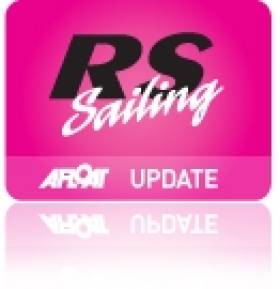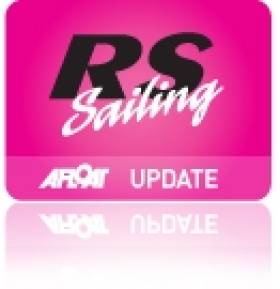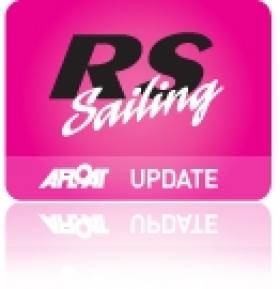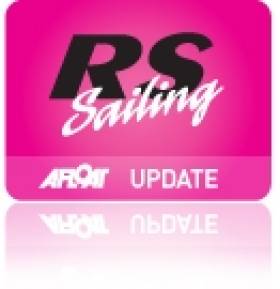Displaying items by tag: RS400
RS400 Fleet Sails for National Honours at Ballyholme Yacht Club
Ballyholme Yacht Club in Belfast Lough was chosen not just for its exemplary history of race management and churning out National Champions, and its excellent access to open waters with minimal tide, but also for its ease of access for the Northern UK Fleet of RS400 sailors, in the hope of attracting some of the biggest names in the UK fleet over writes David Cheyne. So it happened that Mike Sims and Richard Brown, recently crowned UK National Champions and reigning Inland Champs, were tempted, along with Josh Metcalfe and Jack Holden from North Wales, a regular top 5 UK team, to see how much our top teams had improved through 2015. How would the cream of Ireland’s two person dinghy sailors fare against the top names of one of the most competitive fleets in the UK.
Much has been said of the RS400 fleets continued expansion in Ireland, with fleets popping up everywhere, and now strongholds in Cork and Belfast Lough, and ongoing growth in Dublin, Howth and the inland clubs like Killaloe. But how is the standard of sailing coming on? One look at the shots taken from the committee boat down the start line, of about 150 metres length, with no midline sag, is testament to the skills and standard right through the fleet, along with the compression of the fleet which finished most of the 45 minute races within 5 minutes from front to back.
Within the fleet itself, there had been a quiet excitement building towards this event, with everyone turning up, resulting in a stunning line up of talent spanning 40 years, and with nearly the entire top 20 being National Champions or better. However, what was most impressive was how tight the racing turned out to be in rest of the 50 strong fleet. Nobody seemed to be struggling, and everyone was out fiddling with rig settings and fine tuning, only a year on from many people trying to work out how to sail the boats for the first time.
Racing on Friday looked like a walk in the park for the top UK team, who took all the bullets, however after a day off to reflect on the Saturday, when the wind refused to play ball, the Irish teams came out fighting and nearly overhauled the visitors who had a much more torrid time of things, with boats speed difference now neutralised, and any sense of intimidation no longer felt. Notable performances came from established pairing Paul McLaughlin and Mick McKinley of Cushendall, who seemed to be flying around the course and regularly chasing the top 5; Barry McCartin, 2014 and 2015 Irish Fireball Champion, and top Irish performer in 11th place at the recent Fireball Worlds, sailing with Finbar Bradley, not long in the fleet, constantly chasing the leading pack; top Irish Laser sailor and coach Chris Penney, with Simon Martin, and George Kenefick, 2011 ISA Helmsman’s Champion filling out the top ten.
It was clear however, that there was a top 5, with the two top UK teams and three Irish teams of 2014 Champions Alex Barry and Richie Leonard, 2013 Champions Bob Espey and Michael Gunning, and multiple Irish National Champion in many fleets, Gareth Flannigan, with Dave Fletcher of the home club, knocking ten bells out of each other, and indeed Espey out of his boat at one top mark rounding!
Going into the last day, Flannigan was looking strong in pole position, but the points quickly reversed with discards kicking in, and ever present Alex Barry overhauling the Ballyholme duo before Flannigan was black flagged in the penultimate race to really put the pressure on, as Barry claimed his first win of the series. With the expected jostling for position in the final start, it was the Monkstown team who squeezed out ahead, as Flannigan struggled to pull back through from mid fleet, and it was they who claimed their second successive Irish RS400 title.
So how was it for the rest of the competitors? Well, one of the great things about the fleet is the coming together of so many old friends and adversaries of years gone by, with the likes of 63 year old Liam Donnelly, along with Brian Holmes, Richard Bolton, Charlie Horder and Simon Hutchison of the Scorpion fleet of years gone by, all feeling enthused again to be able to compete against each other again after several years without a double hander to sail. It is such a refreshing sight to see 50 dinghies in a single class with jibs and kites whizzing about, after so much concentration on single handed racing in recent years. The fun of having to get so many variables covered in such a beautifully easy boat to sail fast, looks to be re-energising sailing in Ireland. Who knows what 2016 holds – bring it on!
A Day of Two Halves Concludes RS400 Irish Nationals & RS200, RS Feva Northerns at Ballyholme
There was an enforced lay day due to lack of wind at the RS400 Nationals, RS200 and RS Feva Northerns when the fleets decided they'd rather head to the bar at Ballyholme Yacht Club to watch the Ireland v Canada rugby match. This proved so popular that some suggested a lay day in the middle of future events although only if rugby readily available which means we'll have to wait 4 years for the next time.
This morning, Race Officer Robin Gray brought the start time early in a hope to fit in five races if possible before the 1500 time limit. Having witnessed the giant killing of South Africa by Japan on Friday night, some of the locals were hopeful that one of them would be able to take down the all conquering English pairing of Michael Sims and Richard Brown from Carsington Sailing Club in Derbyshire. After the first two races of the day, the upset looked on with Ballyholme's Gareth Flannigan and David Fletcher only 1 point behind with a 3rd and 1st. The other stars of this morning were the Welsh pairing of Josh Metclafe and Jack Holden, conspicuous with one of the few Dacron mains in the Mylar fleet.
In the afternoon however, Alex Barry and Richard Leonard won Race 6 with Michael and Richard just behind. Flannigan and Fletcher scored a DNF, while the other local boat we expected to see featuring earlier – Robert Espey and Michael Gunning scored the first of 2 seconds despite having fallen out of the back of the boat on Race 4. It can happen to anyone.
The breeze all day was a 10-16 knot southerly with flatter water than Friday and little sunshine. The racing was just as tight with the RS400 fleet pushing the line even under U. After a general recall, Race 7 managed to get away cleanly with only 2 minutes before the time limit. The UK National Champions got away cleanly up the middle of the beat and had a comfortable lead by the gate on the downwind, carrying this through to win the race and the Open Championship overall.
They were followed up the beat closely by Flannigan & Fletcher but a busy windward mark and a wrong manoeuvre at the first gybe suddenly found the BYC boat only 10 places from the back, such was the tight nature of racing even for the last race of the day. They recovered to 14th place but not enough to see off the current Irish National Champions Alex Barry and Richard Leonard who slipped through with a 4th to win 2nd overall and retain their title as Irish champions.
The RS200 fleet saw equally tight racing over the 4 races today with only 3 points separating the top 3 of the 20 boat fleet who raced on the outer loop of the trapezoid course. Despite Frank O'Rourke winning 2 of the 4 races, it was Marty O'Leary and Rachel Williamson who won the RS200 Northerns from Sean Craig with Olympian crew Ciara Peelo.
The RS Feva fleet showed good speed with the front boats keeping away from the chasing RS200s until the bottom of the outer loop. In fact such recognition was rewarded by the RS200 fleet dropping to O2 from O3 for all but the first race. The biggest smiles were in Race 3 for Lucy Bell and Emma Greer who won the race courtesy of the 4 boats who were pushing the pin end of the start line all scoring OCS. Alex and Henry Start revelled in the windy conditions all day winning the final race and the RS Feva Northerns Championship.
This was the largest RS400 fleet this summer with 51 boats taking to the water today, and over 80 boats between the 3 classes, and all were thoroughly happy but tired at the end of racing. It was great to see so many boats travelling from all corners of the UK and Ireland and shows the strength of the class, especially when looking at the calibre of the sailors involved with numerous Olympians, offshore talent and National champions. Overall RS400 Eurocup winner Michael Sims thanked Ballyholme Yacht Club, their event team for the great event and warm welcome given to all in Bangor over the weekend, and the sponsors Bangor Fuels, Ards and North Down Borough Council and Corona for their support.
Ballyholme Yacht Club looks forward now to next year with the hosting of the Topper World Championships in July 2016.
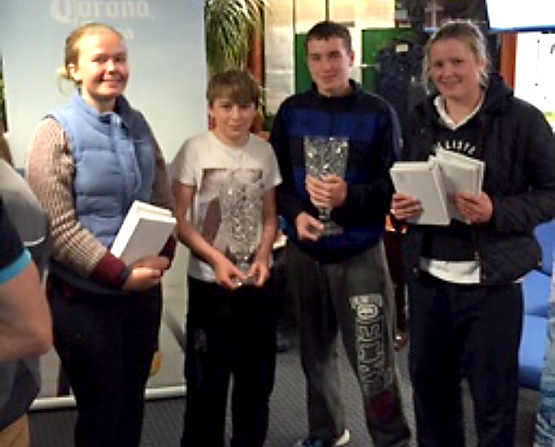

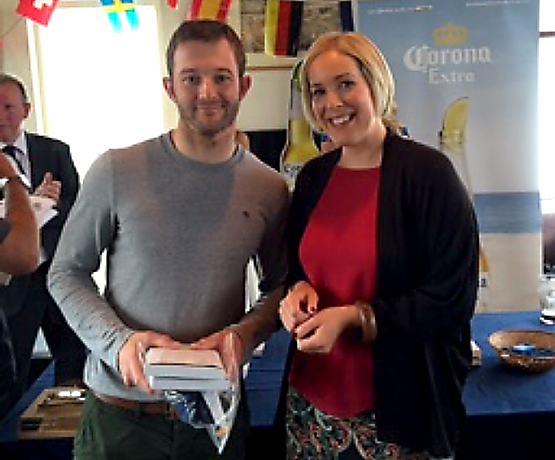
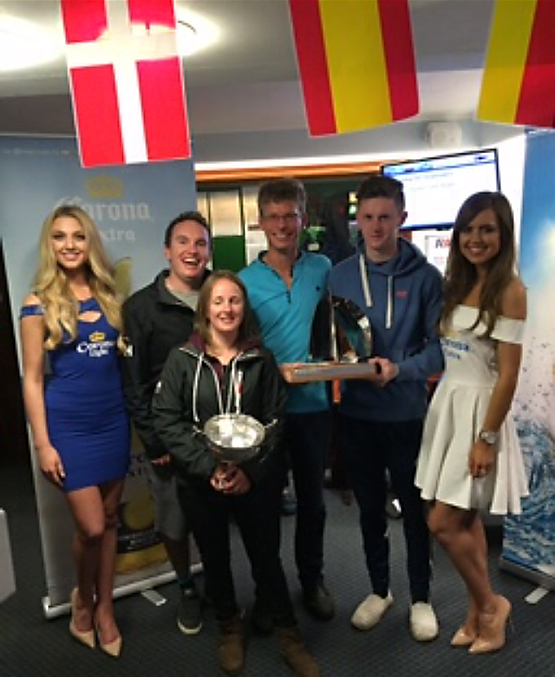
Winners Marty O'Leary and Rachel Williamson with Frank O'Rourke winner of RS200 Travellers trophy and Corona models
RS400
1st Michael Sims and Richard Brown, Carsington Sailing Club, 1, 1, 1, (5), (12), 3, 1 7pts
2nd Alex Barry and Richard Leonard, Monkstown Bay Sailing Club / Royal Cork 2, (7), (4), 2, 2, 1, 4 11pts
3rd Gareth Flannigan and David Fletcher, Ballyholme Yacht Club, 3, 4, 2, 3, 1, (50, DNF), (14) 13pts
4th Josh Metcalfe and Jack Holden, Y Felinheli SC, (5), (11), 3, 1, 3, 5, 3 15pts
5th Robert Espey and Michael Gunning BYC 9, 5, (50, DNF), (10), 4, 2, 2, 22pts
6th Barry McCartin and Finbarr Bradley, Cushendall Sailing Club, 11, 3, 8, 4, (26), (34), 11 37pts
RS200
1st Marty O'Leary and Rachel Williamson, Greystones Sailing Club, 2, 1, 2, (3) 5pts
2nd Sean Craig and Ciara Pello, Malahide Yacht Club, (3), 2, 3, 1, 6pts
3rd Frank O'Rourke and TBC, Greystones Sailing Club 1, 5 ,1 ,(5) 7pts
RS Feva
Alex Start and Henry Start, Royal St George Yacht Club, U18, 2, 3, (12 OCS), 1 6pts
Lucy Bell and Emma Greer, Strangford Lough Yacht Club U16 3, (5), 1, 5 9pts
Catherine Pooler and Anna Wilson, SLYC, U18, 5, (6), 2, 4 11pts
RS400 Dinghy Champs At Ballyhome Yacht Club Draws Top Sailors
As expected, some of the cream of Irish sailing turned up for the first day of the Bangor Fuels RS400 Irish National Championshps which is the third and final stage of the RS400 Eurocup writes Mark Mackey. A scan down the entry list reveals current Olympians – James Espey (Laser) and Ryan Seaton (49er) standing in as skippers for others, Artemis Open 60 and World Record holder Michael "Chunky" Ferguson against solo Figaro sailor David Kenefick, previous ISA youth champions Robbie Gilmore and Chris Eames home from college, and Fireball champion Barry McCartin amongst many others.
We sometimes overuse the term "champagne sailing" at Ballyholme Yacht Club due to the great events we have hosted over recent years but this was the common theme of conversation from the smiling faces as they returned after three "very tight races" today - at least in the "middle to back end" of the fleet. A wrong gybe was said to cost 10 places at an event last year, today it could cost 20 places in surfing waves with sunshine and 10-15 knots of breeze.
Race Officer Robin Gray got the racing off like clockwork with windward-leeward courses being the preferred course of the RS400's today. Just as expected was the first of 4 general recalls with boats pushing both ends of the line. The black flag tamed everyone to a degree until the last of the 3 races when 5 boats just had to try too hard.
Pedigree shows and local boat and multi Irish National champion (although not in RS400's) Gareth Flannigan with David Fletcher lead the Irish charge after day 1 with scores of 3,4,2 but it was the Derbyshire pairing of Michael Sims and Richard Brown from Carsington Sailing Club who revelled best in the conditions with 3 bullets and lead after Day 1 with a 6 point advantage already. A quick look at Sailracer shows Sims and Brown as both UK National RS400 Champions and Gul Inland Champions in the last 12 months. Current RS400 Irish National champions Alex Barry and Richard Leonard from Monkstown Bay and Royal Cork lie 3rd with 2,7,4.
Two more days racing look set with similar conditions tomorrow followed by a bit more breeze on Sunday. The RS200 and RS Feva fleets will also join the RS400's for a "regional championships" starting at midday tomorrow.
The RS400 Irish National Championships are sponsored by Bangor Fuels and supported by Ards and North Down Tourism. More information about visiting Bangor can be found at http://www.visitardsandnorthdown.com/.
RS400 Irish National Championships
1. Michael Sims and Richard Brown, Carsington Sailing Club, 1,1,1
2. Gareth Flannigan and David Fletcher, Ballyholme Yacht Club, 3,4,2
3. Alex Barry and Richard Leonard, Monkstown Bay/ Royal Cork YC 2,7,4
New Faces At Carlingford RS400, RS200 & RS Feva Battle
#rs400 – It was a case of perpetual disorientation, but also a high point for Hastings, one of the fleet's main movers and supporters, as he judged the spiralling wind, or Carlingford Kettle, to perfection writes David Cheyne. As those around him thrashed around helplessly, Hastings bore off in a smooth arc, with crew Neil Calvin maintaining perfect kite trim, and scribed a perfect circle, with no adjustments to sheeting angle, truly an incredible sight for all to witness. As the mini tornados spun their way across the lough, availing of the unique local topography, many others did the more traditional 360 rotation, with the rig passing under the boat, and so it came to pass that we had a very odd days racing on Saturday. With a similar South Westerly breeze forecast for the Sunday, many went to bed worried about another day of randomness.
The writing was on the wall for Saturday, as we started the briefing in 20 knots of South Easterly, and finished in 20 knots of South Westerly 10 minutes later. Most relevant question was probably "how deep is it out there?"
The weekend saw the welcome return to battle of 2013 Circuit kings, Dr Bob "Bucky" Espey, and newly engaged Michael Gunning, finally making it back out after a few forays in the SB20 fleet. It was to be fascinating to see how they would fare against all conquering 2014 RS400 champion, Alex Barry of Monkstown, fresh from his win the 1720 Irish Nationals. As seems to be the case from event to event, the calibre of the RS400 fleet becomes ever more stellar, and there cannot have been many more talent loaded one design fleet racing in Ireland, with most of the top 10 being National Champions in many classes, along with resident World top ten 49er and Irish Olympian, Ryan Seaton helming Pretty Boy's boat in the absence of Chunky Ferguson. Figaro competitor and 2013 Irish Sailor of the Year Dave Kenefick, kicked off proceedings with an impressive bullet and looked like he had got himself dialled in quickly in his new boat, but the standard of those around him was quickly evident and he was to have a tough time thereafter, eventually finishing 10th overall.
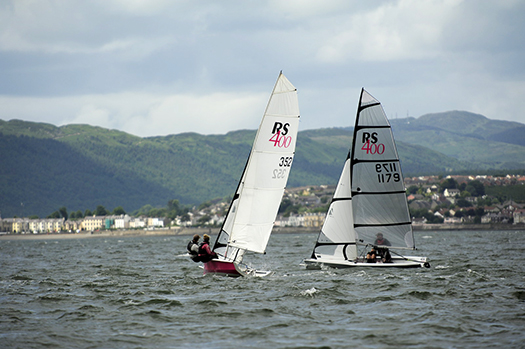
Diane Kissane chases David Rose in race 4
Diane Kissane from Howth was another new face to the fleet, borrowing the RNIYC try-it-out boat #510. Typically for the forward thinking RS400 fleet, these RNIYC enthusiasts bought this old boat for about £1500, on EBay I believe, and it has been given the Uncle Liam tender loving care refurb. Diana with crew Finbar Bradley gave the fleet the big thumbs up, and after finishing 13th out of the 31 boat fleet, plan to hit the circuit next year in their own boat, adding yet another National Champion to the list, Diana having been double Irish Optimist Champion in 2005 and 2006.
After a lot of difficult and competitive sailing, going into the final race, there were just three points separating the top 3 of Bob Espey and Micheal Gunning in first from Chris Penny and Simon Martin in second and third placed David Rose and Ian Heffernan, who had won the first race on day two. Just seven points separated first to sixth. This is a clear indication of the quality that we now have throughout the 400 fleet.
Last year the Southern teams were starting to quickly overhaul the established Northern dominance of Espey and Gareth Flannigan, and whilst Flannigan had a mixed event and was to succumb to gear failure after a 2nd place in the Sunday morning opener, the top two slots were to go to the brilliant Espey followed by Olympian Ryan Seaton and Philip Adams, with Ex 400 Irish Champs Emmet and James Ryan two points clear of Rose and Heffernan in third and fourth. Chris and Simon had to settle for fifth.
Other notable performances were from Paul McLaughlin and Mick McKinley in 9th, and a strong showing from George Kingston and Ian McNamee in 7th, taking a split decision over the highly talented, but well past sell by date pairing of DrC and Stevie Kane, who shocked themselves by posting the best total over three races on Sunday (only getting this mention as I am writing the report obviously). Alex Barry, sailing this time with Andrew Lane finished an unaccustomed 6th after being joint leaders overnight.
Other big improvers were Brian Holmes sailing with a completely new crew, progressing nicely and representing the Scorpion fleet of yore, and Peter Bayley getting well in the mix. Sadly, our eldest statesman Liam Donnelly, succumbed to a Mountain Biking injury, and a punctured lung, and wasn't able to race on Sunday, but will no doubt be back to full fighting form for the next one.
So things go from strength to strength in the 400s, with an amazing 31 boats for a regional, and one can only imagine a record turnout for the Irish Nationals 18-20 September at Ballyholme, with about 10 extra teams expected from the UK fleet in what should be the hardest fought of any Irish Championships in 2015.
RS200 and Feva :
In the RS200 fleet, Greystones SC pairing of Aaron Jones and Conor Cleary dominated from the off scoring five straight race wins which allowed them to sit out the final race and be first boat ashore. Ensuring that Jones and Cleary were kept on their toes for the weekend was Meg Tyrell and Katie Noonan from the Royal Irish/Greystones. They scored five 2nd places and a well-deserved win in the final race. In third place was Ciaran & Siobhan Keogh with a great showing representing the newly emerging Cullaun Sailing Club RS fleet.

The RS Feva fleet enjoyed a competitive event with three different race winners all hailing from Dun Laoghaire. The top three boats showed great consistency in spite of the shifty conditions, with none of them scoring worse than a 3rd placing. Coming out on top was Toby Hudson Fowler and Greg Arrowsmith who grew in confidence as the weekend progressed winning the final four races. In second was a very impressive display by Triona Hinkson and Kathy Kelly who managed to hold off the challenge of Clare Gorman and Sarah Fogarty in third.
#rssailing – Monkstown Bay Sailing Club's Alex Barry and Richard Leonard got the jump they needed when they won the final race of the RS400 Euro–cup in Carnac, France yesterday.
Two races were scheduled for the final day of the Cup. With First gun at 10:30 and no warning signal allowed passed 13:00, it was a tight window.
One race was eventually sailed in 5 – 8 knots from the North and glorious sunshine.
The Cork harbour pair lead the race from start to finish and with their closest competitors having a poor race it meant they moved up to third overall and a prized podium finish.
The race for the overall title was extremely tight with Jim Downer and Jono Price from Cowes winning on count back.
Results downloadable below.
Additional report from David Rose below:
Excellent race management, in mixed conditions over four days, made for a brilliant RS Eurocup in Carnac at the weekend for the large RS fleets competing. The RS400 had the largest, and one of the most competitive fleets with 31 entries.
Emmet Ryan, who had travelled to a well-attended Garda event last season, and was coming off the back of a 3rd place at a very competitive Irish Eastern Champs with brother James, commented that the standard at this year's European adventure was every bit as high as the top class racing he had experienced in the Italian mountains twelve months earlier. Like at that event, Emmet started really strongly, and was best of the Irish with two 8th place finishes on day one. The Ryan's were to remain consistent for the rest of the regatta, never really hitting the dizzy heights they are capable of, apart from one 5th place. They were extremely consistent with only one race outside the top 10, and will no doubt be competing for honours in Ireland all season.
Day two involved a good deal more hiking, with plaining conditions and 3 longer than usual races. When the sweat settled, Alex Barry and Richard Leonard had put in a great shift and brought themselves back in touch with the top end of the fleet after an average first day, with a 6, 3, 1. This form was to continue for another two days, with two races sailed on day 3 and one on day 4. In the final race Alex / Richard were to lead at every mark and record a second bullet in the event. This mercurial team from MBSC/RCYC, who have become accustomed to the winning circle at the Irish events just kept reeling in and passing competitors on the score board, akin to Rory Mac on birdie charge. They were to run out of races in 3rd position, a brilliant result for them, their clubs MBSC and RCYC and for Ireland.
Paul Mc Laughlin and his crew and only lady to travel Michael Mc Minkey performed admirably and finished up in 14th place, followed by Robert O' Sullivan and David Whitaker who faired particularly well on day one, and were to finish 19th. 'Uncle' Liam Donnelly and his crew Richard Mc Caid came in a respectable 22nd overall.
The Irish RS400 fleets was well represented by the following teams in order of their finishing places:
3rd - Alex Barry & Richard Leonard MBSC / RCYC
11th – Emmet Ryan & James Ryan RSTGYC
14th – Paul Mc Laughlin & Michael Mc Minkey
19th – Robert O' Sullivan & David Whitaker MBSC / RCYC
22nd – Liam Donnelly and Richard Mc Caid RNIYC
#RS400 – After seven races sailed at the RS400 Cup in Carnac, France, Cork Harbour pair Alex Barry and Richard from Leonard from Monkstown Bay Sailing Club stay fourth after counting a three and a six in yesterday's two 15-knot races.
Two more races to complete the series are scheduled for this morning but with a first gun at 10:30 and the breeze typically not arriving in the Bay of Quiberon before 1300 all week there is a question mark over whether a full programme being can be sailed. No race can start after 13:00 today but if racing takes place a second discard applies.
#rs400 – Mid–way through the RS400 Eurocup in Carnac, France and Monkstown Bay Sailing Club's Alex Barry and Richard Leonard lie fourth overall in the international dinghy sailing championships. The Cork Harbour duo 'pulled it together' yesterday afternoon with a 6,3,1 scored to move into medal contention in the 31–boat fleet.
There were blue skies in Carnac and 12 knots of breeze for yesterday's races.The AP was raised ashore until the breeze filled in at 1pm. The three races yesterday were sailed in a very steady breeze. Three more races are scheduled today and two for Tuesday.
Former Irish SB3 Sailor Escapes Death In Everest Avalanche
#Nepal - A British woman who previously raced SB3s on the Irish sailing circuit has spoken of her miracle escape from an avalanche at Mount Everest during last weekend's Nepal earthquake disaster.
As the Daily Telegraph reports, Selina Dicker from Norfolk, who was on a climbing expedition to the word's highest peak, told how she outran the deadly wall of snow as it careened towards her group.
The avalanche claimed the life of fellow climber Daniel Fredinburg and left two others critically injured.
But Dicker narrowly avoided the same fate when she ran to a ridge at the edge of their base camp – and later contacted her relieved family by satellite phone to explain what happened.
Dicker should be familiar to Dublin Bay sailors from racing her SB3 named Kicker Off, and teaming with Wayfarer champ Trevor Fisher for the RS400 Sprint Trophy in October 2011.
The Daily Telegraph has more on the story HERE.
RS Dinghy Sailors Take Unusual Course At DMYC Frostbites
#rssailing – A chilly Easterly breeze in the mid-teens kept the RS fleet on their toes for Sunday's two four lap races. With the unusual wind direction came an unusual course. Well, the same trapezoid course but with starboard hand mark rounding's instead of port.
With right hand turns and the top mark positioned under the East Pier, the first bear away proved to be a bit of a minefield. The RS fleet had to pick their way through capsized Laser and PY masts before figuring out if it was too tight to hoist the kite or not.
In race one there were plenty of lead changes at the front between Alexander Rumball, Sean Cleary and Emmet Ryan in the RS400's. Unfortunately Alexander fell victim to a semi submerged PY mast, with his rudder blade coming off second best. In the end the Ryan brothers edged out Sean Cleary by half a boat length. In the RS200's super sub Graeme Grant of Howth Yacht Club filling in for Marty O'Leary claimed top 200 spot.
With the weather mark moved slightly away from the confused wind zone under the pier, race two settled down quite quickly after the first mark. Sean Cleary led the fleet home with a comfortable win form Emmet Ryan. Graeme Grant again showed the 200's the way but was kept honest throughout the race with Conor Totterdell snapping at his heals until the very end.
Two more weekends of Frostbite racing remain, then the RS classes look forward to joining in DBSC Tuesday night racing. For the coming season DBSC have recognised the huge growth in popularity of the RS200's and RS400's and will be giving and RS's a class start for the first time for the DBSC summer series.
Shifty, Gusty For RS200s & RS400s Dun Laoghaire Race
#RS – A strong gusty breeze scared off more than a few of the usual competitors from the DMYC Frostbite Series on Sunday the 8th of March, and a reduced fleet were left wondering as two o'clock approached whether or not racing was going to happen. The race committee decided to postpone by fifteen minutes to see whether or not the wind was going to drop as forecast, they were proven correct, and set the usual trapezoidal course inside the harbour in an ideal ten to fifteen knots, and due to the postponement, made it slightly shorter than usual, signalling four laps. The start was an interesting affair, with all the RS400s and O'Leary and Willliamson's 200 deciding to fight over the favoured boat end. All their efforts came to nothing however, as a general recall was signalled because the wrong flags were used to start the race!
The restart came off cleaner, with Rumball and Brazel getting a clear start slightly to windward of Cleary, with O'Leary and Williamson having to make a quick tack into clear air.
All boats found the shifty, gusty conditions a struggle and it was Rumball and Brazel's 400 that made it to the windward mark in first position, followed by Cleary and O'Leary being the first 200.
The top reach was a very gusty place, with not too many braving a kite after the first lap, when the breeze decided to come up. The lead was hard fought until the second reach, where Cleary's choice to chance a kite proved costly, as they where dragged to leeward by the 400's large asymmetric and they lost ground to Rumball, who decided not to take the risk. The order of the fleet stayed pretty much static from there on in, with Rumball and Brazel taking line honours, and O'Leary and Williamson being the first RS200 home. All in all it was another ideal day to be racing in Dun Laoghaire, with the sun even choosing to make an appearance a few times!
Thanks to Kevin Brazel for this weeks report and Sean Clery for the video.


























